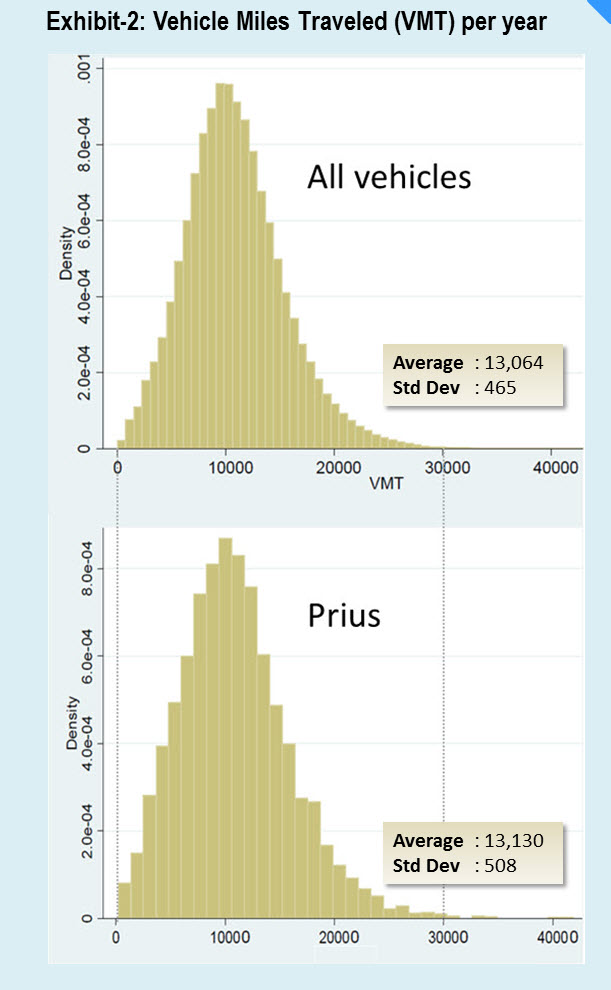The Prius fallacy fallacy
 Tuesday, April 3, 2012 at 04:37PM
Tuesday, April 3, 2012 at 04:37PM In the never-ending attack on vehicle fuel efficiency regulations, "the Prius fallacy" has become shorthand for the argument that when one replaces his gas guzzler with a fuel efficient vehicle his gasoline consumption does not go down, or goes down only a little bit, because he will decide to use the lower cost per mile to drive many more miles. (Some economists refer to this more generally as the "rebound effect.") Although it's plausible to think this could happen, it turns out it doesn't. Afsah and Salcito at CO2 Scorecard, using data compiled by Yale professor Ken Gillingham for his doctoral research at Stanford, show that the distribution of vehicle miles traveled ("VMT") by Prius drivers is essentially the same as the average of all other vehicle owners in California.

After driving a series of Audi A4s for 11 years, last year I bought a Prius. Now, instead of 23 MPG, I get 46 MPG actual road mileage. So, do I drive more miles now? No. In fact, I drive fewer long distance miles because the Prius is a less comfortable road car. In our first trip of about 250 miles with three people in the car, we learned that the back seat has inadequate head room. On a 1,100 mile trip with two people, we learned that the seats are way less comfortable than the Audi seats. Also, the Prius has fewer features and a generally lower level of luxury and comfort, and is not, compared to the Audi, at all peppy, responsive, or "fun to drive." Since we still have an Audi in the family, we use it for long trips and trips with three or more adults. Bottom line: The differences that make the Prius more fuel efficient also make me drive it less—the Prius fallacy is a fallacy.
There's another factor countering the Prius fallacy—economy cars do not raise ones social status. The most conspicuous form of discretionary driving is "cruising," and it's really hard to imagine hundreds of Prius owners driving Woodward Avenue in Detroit or Whittier Boulevard in East LA to show off their rides. I don't think that could even happen on Wilshire Boulevard in the Peoples Republic of Santa Monica. Auto industry journalist, Jamie Lincoln Kitman, responds to the Prius fallacy proponents this way:
Although their math is often specious, these critics lose sight of the fact that for more than a century, the automobile industry has been based on selling people dreams to go with their mobility. We're used to drivers who want an S.U.V. or a sports car so they'll look virile, sporty or capable.
The Kitman link is to a forum where others espouse the Prius fallacy. The argument seems to arise out of an unexamined conviction that the only proper—and effective—way to influence social outcomes is by manipulating prices. The truth is sometimes that works, and sometimes it doesn't. As a result of government command-and-control regulations, tailpipe emissions of HC, NOx, and CO from new cars are down 89% since the early 1950s, fuel consumption per VMT is down 40% from 1975, and each VMT is 85% less likely to result in a fatality than it was in 1949. Take the challenge: What's the market alternative to this big government program?


Reader Comments (1)
Good post.
The idea that a higher mileage vehicle will induce one to drive more miles - except in some incremental way - doesn't even pass a laugh test.
Even without the creature comfort considerations you mention, how much driving is really discretionary? Every bit of driving I do is to serve some specific goal. Sitting behind the wheel is literally a means to an end. I can't imagine anyone's driving going up by more than about 10% as a far-out maximum, just because the car gets twice the mileage.
For the most part, people are far too busy to go joy riding.
Cheers!
JzB